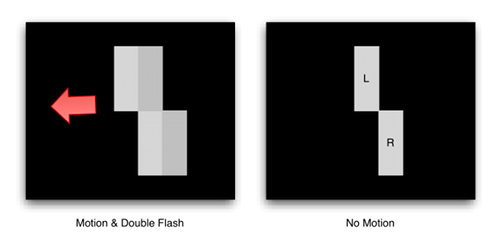While exploring the limitations of motion in high frame rate cinema, Ian Bidgood of Park Road Post in New Zealand discovered an interesting anomaly when viewing rendered white rectangles moving across a dark screen, in a manner reminiscent of the early “Pong” game. Under the right conditions, the moving rectangles double in width. In an effort to get more eyeballs on the problem, Ian’s clips were viewed recently in Burbank.
Bear with us while we explain the conditions under which this anomaly occurs. The moving image must be shown in 3-D, even though the errant effect is visible without 3-D glasses. The sequential 3-D projection of left and right images must be set to double flash. (The nature of double and triple flashing is explained elsewhere.) Under this condition, the moving image was observed at both 24 fps per eye, and 48 fps per eye. At both frame rates, the moving white rectangular block doubled in width. (See the image below.) At 48 fps per eye, the doubled image was much clearer. The appearance is that two sequential flashes of the rectangular block are observed simultaneously. The quick explanation is that the doubling effect is due to persistence of the eye, but it’s unlikely to be just a persistence problem.

It’s more likely that the anomaly is the result of a sampling issue. The motion of the image has a spatial frequency. The flashing of the image has a sampling frequency and a shutter angle. Where different frequencies are involved, there’s the potential for the frequencies to beat. In addition, the human visual system tends to fill in gaps in motion, an effect called the “phi” phenomenon.
The important question to ask is whether or not this is a problem? The phenomenon was shown to be present with 24 fps per eye 3-D, which means we’re already living with it. Until Ian’s clip was created, no one complained. That says something.
While no one has come forth with a clear explanation for the problem, it appears to be the result of some unusual confluence of events. Hopefully, more clips will be rendered at different travel rates for the paddles to develop more clues.